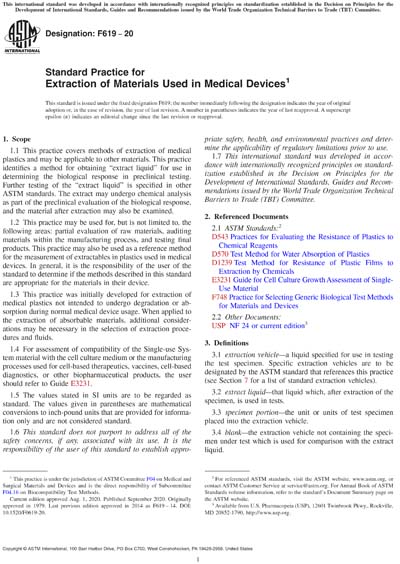Most recent
ASTM F619-20
Standard Practice for Extraction of Materials Used in Medical Devices
1.1 This practice covers methods of extraction of medical plastics and may be applicable to other materials. This practice identifies a method for obtaining “extract liquid” for use in determining the biological response in preclinical testing. Further testing of the “extract liquid” is specified in other ASTM standards. The extract may undergo chemical analysis as part of the preclinical evaluation of the biological response, and the material after extraction may also be examined.
1.2 This practice may be used for, but is not limited to, the following areas: partial evaluation of raw materials, auditing materials within the manufacturing process, and testing final products. This practice may also be used as a reference method for the measurement of extractables in plastics used in medical devices. In general, it is the responsibility of the user of the standard to determine if the methods described in this standard are appropriate for the materials in their device.
1.3 This practice was initially developed for extraction of medical plastics not intended to undergo degradation or absorption during normal medical device usage. When applied to the extraction of absorbable materials, additional considerations may be necessary in the selection of extraction procedures and fluids.
1.4 For assessment of compatibility of the Single-use System material with the cell culture medium or the manufacturing processes used for cell-based therapeutics, vaccines, cell-based diagnostics, or other biopharmaceutical products, the user should refer to Guide E3231.
1.5 The values stated in SI units are to be regarded as standard. The values given in parentheses are mathematical conversions to inch-pound units that are provided for information only and are not considered standard.
1.6 This standard does not purport to address all of the safety concerns, if any, associated with its use. It is the responsibility of the user of this standard to establish appropriate safety, health, and environmental practices and determine the applicability of regulatory limitations prior to use.
1.7 This international standard was developed in accordance with internationally recognized principles on standardization established in the Decision on Principles for the Development of International Standards, Guides and Recommendations issued by the World Trade Organization Technical Barriers to Trade (TBT) Committee.
Content Provider
ASTM International [astm]






